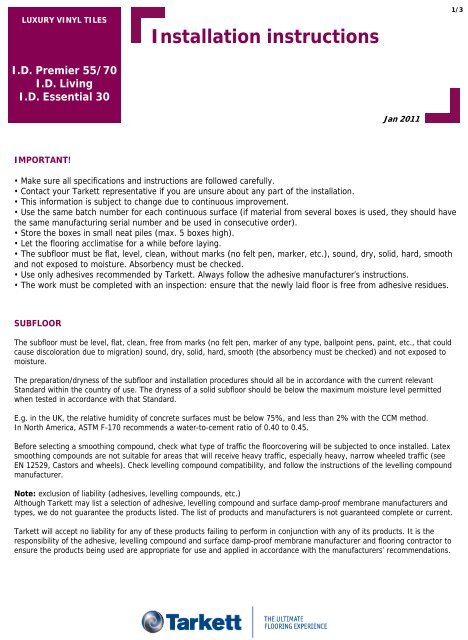Installation Instructions - Tarkett
Installation Instructions - Tarkett
Installation Instructions - Tarkett
Create successful ePaper yourself
Turn your PDF publications into a flip-book with our unique Google optimized e-Paper software.
LUXURY VINYL TILES<strong>Installation</strong> instructions1/3I.D. Premier 55/70I.D. LivingI.D. Essential 30Jan 2011IMPORTANT!• Make sure all specifications and instructions are followed carefully.• Contact your <strong>Tarkett</strong> representative if you are unsure about any part of the installation.• This information is subject to change due to continuous improvement.• Use the same batch number for each continuous surface (if material from several boxes is used, they should havethe same manufacturing serial number and be used in consecutive order).• Store the boxes in small neat piles (max. 5 boxes high).• Let the flooring acclimatise for a while before laying.• The subfloor must be flat, level, clean, without marks (no felt pen, marker, etc.), sound, dry, solid, hard, smoothand not exposed to moisture. Absorbency must be checked.• Use only adhesives recommended by <strong>Tarkett</strong>. Always follow the adhesive manufacturer’s instructions.• The work must be completed with an inspection: ensure that the newly laid floor is free from adhesive residues.SUBFLOORThe subfloor must be level, flat, clean, free from marks (no felt pen, marker of any type, ballpoint pens, paint, etc., that couldcause discoloration due to migration) sound, dry, solid, hard, smooth (the absorbency must be checked) and not exposed tomoisture.The preparation/dryness of the subfloor and installation procedures should all be in accordance with the current relevantStandard within the country of use. The dryness of a solid subfloor should be below the maximum moisture level permittedwhen tested in accordance with that Standard.E.g. in the UK, the relative humidity of concrete surfaces must be below 75%, and less than 2% with the CCM method.In North America, ASTM F-170 recommends a water-to-cement ratio of 0.40 to 0.45.Before selecting a smoothing compound, check what type of traffic the floorcovering will be subjected to once installed. Latexsmoothing compounds are not suitable for areas that will receive heavy traffic, especially heavy, narrow wheeled traffic (seeEN 12529, Castors and wheels). Check levelling compound compatibility, and follow the instructions of the levelling compoundmanufacturer.Note: exclusion of liability (adhesives, levelling compounds, etc.)Although <strong>Tarkett</strong> may list a selection of adhesive, levelling compound and surface damp-proof membrane manufacturers andtypes, we do not guarantee the products listed. The list of products and manufacturers is not guaranteed complete or current.<strong>Tarkett</strong> will accept no liability for any of these products failing to perform in conjunction with any of its products. It is theresponsibility of the adhesive, levelling compound and surface damp-proof membrane manufacturer and flooring contractor toensure the products being used are appropriate for use and applied in accordance with the manufacturers’ recommendations.
2/3CONDITIONS REQUIRED FOR INSTALLATIONIt is important to store the tiles/planks for at least 24 hours before installation at a minimum room temperature of 15°C. Thistemperature should be maintained throughout the installation.The minimum temperature of the subfloor should be 10°C.The recommended relative humidity inside the room should be 50-60%.Tiles/planks should be stored flat in their packages, in small neat piles (max. 5 boxes high).UNDERFLOOR HEATINGIt is imperative that underfloor heating systems have been previously commissioned and found to be functioning correctlybefore installation of the floorcovering.Ensure that the underfloor heating system is switched off 48 hours before installation of the floorcovering commences, andremains off for at least 48 hours after installation is completed. While the underfloor heating system is off, an alternativeheating source should be provided, if required, to ensure that the installation area is kept at a constant temperature of 18-27°C.Gradually increase the temperature over a number of days by only a few degrees per day until the desired room temperatureis reached.The temperature should never exceed the floorcovering industry’s agreed maximum of 27°C on the underside of thefloorcovering (the adhesive line). Where underfloor heating is used, we recommend that vinyl tiles are hot welded.LAYING DIRECTIONBefore starting to install tiles/planks, determine the type of laying taking into account the shape of the room andthe design to be laid. See the various methods on the separate sheet.Important! Before laying the first rows of tiles, check that:- the cut tiles closest to the walls are more than 10 cm wide;- at doorways and corners, the cut tiles are not less than half a whole tile.TilesTiles are marked on the reverse with arrows. Tiles should be laid in a checkerboard pattern.PlanksStagger each row of planks to ensure that the end joints do not coincide with the previous row installed.GLUING 1Glue with an acrylic adhesive emulsion recommended by <strong>Tarkett</strong>. Apply about 250 g/m 2 using the recommended trowel (A1 orA2).Place the tiles or planks edge to edge.The flooring should be rolled twice with a heavy roller immediately after installation to flatten the adhesive ridges. It is alsopossible to do this manually, using a piece of board with a rounded edge.1 For more details on gluing, please refer to the separate sheet: Adhesives.<strong>Installation</strong> instructions / Luxury Vinyl Tiles
3/3AFTER INSTALLATIONIMPORTANT! Wait 48 to 72 hours before allowing any foot traffic or moving in furniture.Protection of installationIf building work is carried out after installation, the floor should always be protected by covering it with hardboard or plywoodsheeting. Masking tape must not be stuck directly to the floor. Never subject a newly installed floorcovering to heavy wheeledtraffic at an early stage, as this will force adhesive from beneath the floorcovering.Initial site cleanAn initial site clean is always recommended before the new floorcovering is commissioned.Residual adhesive should be removed with methylated spirits and a clean cloth.Lightly soiled floors: vacuum, sweep or damp mop the area to remove loose dirt and building dust. A combined machine is veryeffective for large areas (combined scrubber/dryer with cylindrical brushes for safety flooring).<strong>Installation</strong> instructions / Luxury Vinyl Tiles











